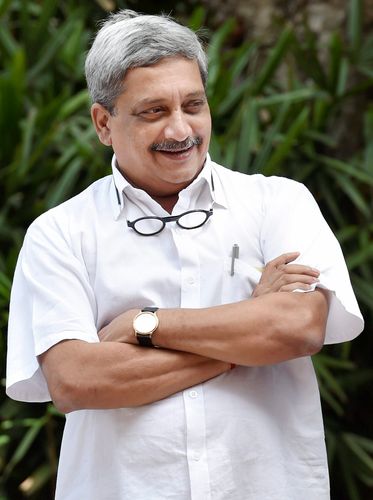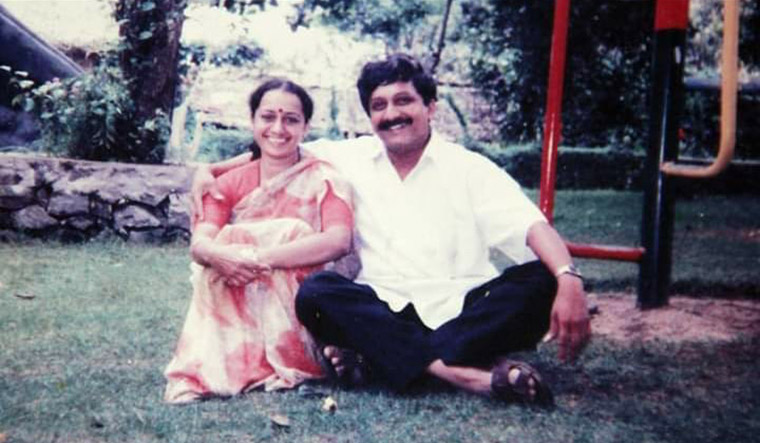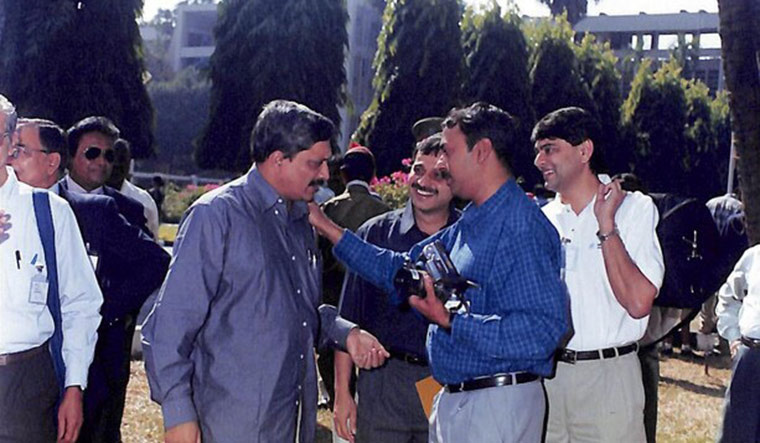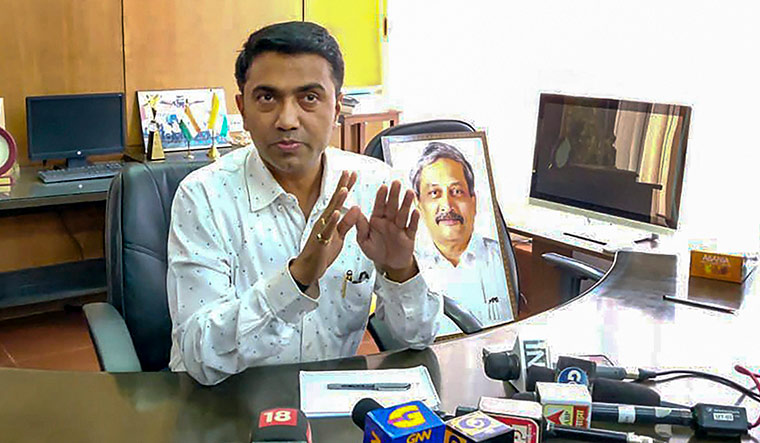The year was 1994. For the first time, the BJP had won seats in the Goa assembly. Manohar Parrikar, 39, and three of his party colleagues—Shripad Naik, Digambar Kamat and Narhar Haldankar—were elected.
The Congress, which had won 18 of 40 seats in the assembly, made its satrap Pratapsingh Rane chief minister. Parrikar told his colleagues that they had to launch an offensive against the Rane government in the first year itself. It was the surest way to create an impression in the minds of the voters, he said. He then identified four ministers who faced the most number of corruption charges, and launched a campaign against the “gang of four thieves”.
The campaign had double impact. First, it put the Rane government on the back-foot; second, Parrikar emerged as the leader of a party that was relatively new on Goan soil.
After that year, Parrikar never looked back. He went on to become opposition leader, chief minister and defence minister. His star kept rising and rising, till he succumbed to pancreatic cancer on March 17. He was 63.
Parrikar had been in and out of hospital since January last year, undergoing treatment in Goa, Mumbai, Delhi and the US. Despite his serious illness, he continued to be active as chief minister. Some say he did so because he wanted to die immersed in work, just like Bhausaheb Bandodkar had. The legendary Bandodkar, Goa’s first chief minister, had died in office in 1973.
Manohar Gopalkrishna Prabhu Parrikar was born in a traditional Gaud Saraswat Brahmin family at Parra village. His father, a simple man who led an austere life, had a grocery store in Mapusa. As a child, Parrikar started attending an RSS shakha so that he could play with a large group of boys. Subhash Welingkar, the former RSS chief in Goa who later fell out with Parrikar, often described him as ‘Bal Swayamsevak’.
One of the first to spot the spark in Parrikar was Durganand Nadkarni, who was RSS pracharak in charge of Goa. It was Nadkarni who groomed Parrikar as he rose through the RSS ranks till 1973, when he left for Mumbai to enrol in the IIT there. Parrikar completed his BTech in metallurgy in 1978.
A story from his IIT days shows Parrikar’s leadership style. One day, workers at the students’ mess went on strike. Being the mess secretary, Parrikar had an excellent relation with them, but he also knew that the students could not afford to eat outside. So he organised his friends into groups and delegated cooking-related responsibilities to each group. Soon, students began purchasing vegetables, cooking food and managing the kitchen. When the mess workers realised that the strike was not having the desired effect, they agreed to resume work. Parrikar, not one to hold a grudge, helped the workers take their demands to the IIT director.
After graduation, Parrikar worked briefly at Mukand Iron and Steel Works Ltd, before returning to Goa to start a factory. In the last year of his stay in Mumbai, he also married Medha Kotnis, whom he had been courting. The couple had two sons, Utpal and Abhijaat.
Parrikar became RSS sanghchalak of Mapusa when he was just 30. The BJP, which had been formed in 1980, was yet to make inroads into Goa. When the party finally entered Goa politics in 1988, the RSS decided to depute two of its most talented office-bearers—Parrikar and Shripad Naik—to the BJP.
“My relations with Parrikar date back to 1989, when we began working for the BJP,” said Naik, now Union minister. “Parrikar’s sharp intellect and decision-making skills helped us a lot. He was the brightest among the four of us who got elected in 1994.”
During the Ram Janmabhoomi agitation, Naik led a group of karsevaks from South Goa to Uttar Pradesh, while Parrikar led another from North Goa. Both the groups were stopped and arrested at Jhansi.
There is an interesting story about how Parrikar came to contest the Lok Sabha elections in 1991 from North Goa. Back then, Pramod Mahajan was in charge of the BJP’s Goa unit. In the run-up to the polls, Parrikar told Mahajan bluntly that there was no deserving candidate in the BJP. Mahajan told him that he knew one candidate. Parrikar asked who it was, and Mahajan replied that it was none other than Parrikar himself.
Govind Gaude, Goa’s minister of culture, recalled becoming an admirer of Parrikar at their very first meeting. “It was in the mid-1990s, and I had just graduated,” he said. “Parrikar and I met at a social function. He was a legislator at that time. What impressed me the most was his drive, oratorial skills and understanding of the issues that Goa faced. I walked up to him at that function and told him that he should become chief minister. He eventually did become CM and, as luck would have it, I became minister in his government in 2017.”
Despite having been a swayamsevak, Parrikar never allowed the RSS ideology to weigh him down in politics. The foresight with which he built ties with Catholics in Goa is testimony to that. In 2004, during his first term as chief minister, Parrikar began Mission Salcette, an ambitious and systematic plan to take the BJP closer to Christians.
The mission, which was named after a region in South Goa, had the BJP fielding its MP from South Goa, Ramakant Angle, against Congress strongman Churchill Alemao in the Lok Sabha elections that year. The result was a foregone conclusion, as South Goa is a Christian-majority region. Still, Parrikar went from village to village, meeting people in South Goa.
Though Angle was defeated, the results of Mission Salcette were evident in the 2012 assembly elections. Almost all Christian candidates that the BJP had fielded from seats in South Goa won the polls.
“Parrikar always believed in inclusive politics,” said Narendra Sawaikar, BJP MP from South Goa. “He realised that Christians were not supporting the BJP, so he took it upon himself to meet the community and explain the work done by his government and the Vajpayee government. For more than a month, he visited villages in Salcette every evening to interact with the people. This helped us a lot in later years.”
Sawaikar also remembered how Parrikar had helped him when he contested from the seat for the first time in 2009. “You are the BJP candidate for South Goa, he told me. I was just a general secretary of the BJP then, and had no experience in electoral politics. I requested his help,” said Sawaikar. “Parrikar sat down and drew up a time table for the next 90 days. He outlined how I should campaign, and told me that he would spend some time with me every day. He was true to his words. He did not miss a single important rally that I had to address.”
His affable nature did not stop Parrikar from speaking his mind. In 2009, he likened BJP veteran L.K. Advani to a rancid pickle. The comments, understandably, caused a lot of controversy. In 2013, he was the first BJP chief minister to openly support Narendra Modi as the BJP’s prime minister candidate. As defence minister, he said going to Pakistan and going to hell were one and the same. He also said he did not agree with India’s “No first use” policy regarding nuclear weapons. It was during his tenure as defence minister that India carried out a cross-border surgical strike after the September 2016 terror attack at Uri.
In Goa, Parrikar will be remembered for his vision and development initiatives. “Parrikar’s biggest contribution to the state was in the field of infrastructure development,” said Shrinivas Dempo, chairman of the Dempo group. “He built roads and bridges, brought festivals like the International Film Festival of India, and organised Lusofonia Games (a multi-sport event of athletes from Portuguese speaking territories, held in Goa in 2014). In his last term, he was working to attract knowledge industries to Goa.”
Michael Lobo, deputy speaker of the assembly, said Parrikar loved his fish curry and rice. “He would call in advance and tell me that he was coming home for dinner. He would also tell me which fish he wanted to eat that day. Goan chicken xacuti was another favourite dish of his,” said Lobo.
Parrikar’s death is an immense loss for the BJP. In many ways, he was the party in Goa—he towered over other leaders, and he did not groom a second line of leadership. As chief minister, he controlled more than 25 portfolios.
Naturally, his death left the BJP-led state government in the lurch. The BJP’s partners in the ruling coalition—the Maharashtrawadi Gomantak Party and the Goa Forward Party—had made it clear that they supported the Parrikar government and not the BJP.
With Parrikar’s death, Public Works Minister Sudin Dhavalikar of the MGP and Health Minister Vishwajit Rane of the BJP were in the race to become chief minister. The BJP, however, made it clear that Dhavalikar would not be made chief minister, as it would have upset GFP leader Vijai Sardesai.
BJP president Amit Shah and Union Minister Nitin Gadkari held long discussions at Cidade De Goa Hotel in Panaji, after which it was decided that no recent entrant to the BJP would be made chief minister. It meant Rane, who had quit the Congress in 2017, was out.
After much deliberations, the BJP picked Speaker Pramod Sawant. Sawant, a 45-year-old who trained as an ayurveda doctor and holds a master’s degree in social work, was apparently seen as the most loyal of the five Hindu BJP legislators. (Seven BJP legislators are Catholics.)
That Parrikar had handpicked him in 2012 to contest from Sanquelim assembly constituency worked in Sawant’s favour. He had also never lobbied to get a cabinet berth.
Sawant was sworn in as chief minister at 1:45am on March 19. Sardesai and Dhavalikar were made deputy chief ministers—the first time Goa was getting two deputy CMs. “We will work as a team. We believe in ‘Sabka Saath, Sabka Vikas’,” Sawant said after taking charge.
The stability of his government, however, is in question. The Goa assembly has 36 legislators now. Fourteen of them belong to the Congress, 12 to the BJP, three each to the MGP and the GFP, and one to the Nationalist Congress Party. There are three independents, all supporting the BJP.
Raju Nayak, editor of the Goa edition of Lokmat, said the fate of the Sawant-led government was tied to that of the Modi government at the Centre. “Stability in Goa depends on who wins the Lok Sabha elections,” he said. “If the BJP comes to power once again, there would no trouble for the Sawant government. But, if the BJP loses, this government could collapse in a month.”
Sawant, however, plans to hit the ground running. “I will work towards streamlining the administration and strengthening infrastructure and human development,” he said. “By human development I mean thrust on social schemes.”
And what about the Lok Sabha polls? “The BJP will win both the seats,” he said. “I have got a good team of colleagues. We are together in this.”
Shrinivas Dempo said Sawant would have his hands full managing the coalition and reviving the economy. “Parrikar would surely have worked out a solution in his trademark style,” he said. “But now that he is gone, we have to see how Sawant manages the economy. Closure of mining has affected thousands of people in the hinterlands, while tourism is limited to coastal areas only. How he handles issues like mining revival and bringing knowledge-based industries to Goa is what remains to be seen.”





